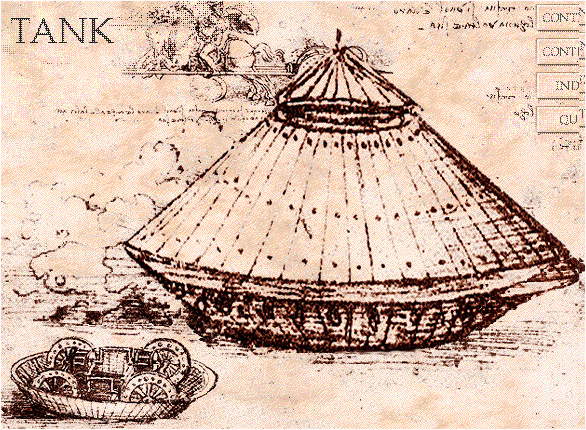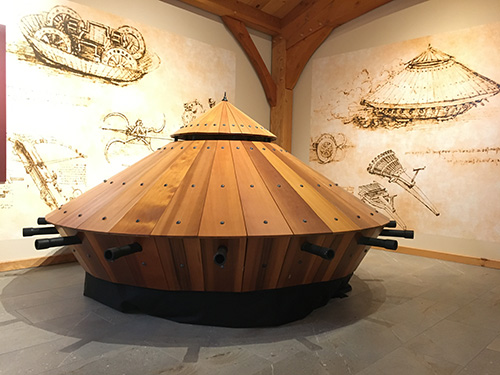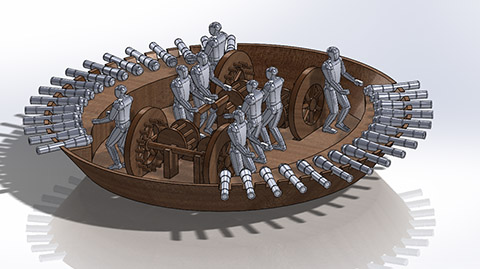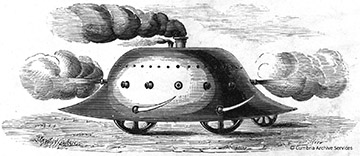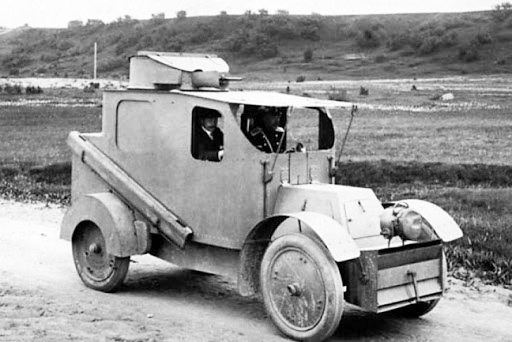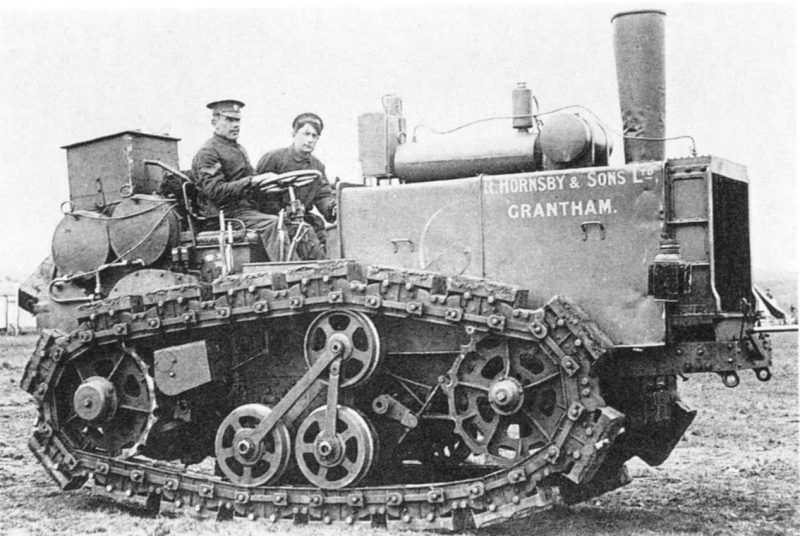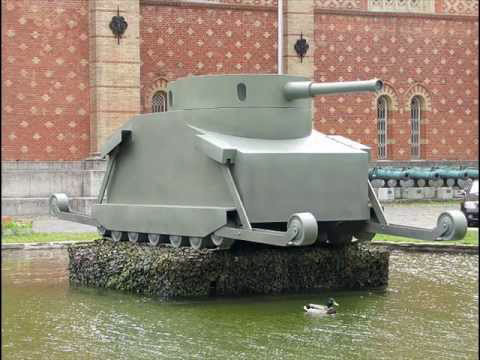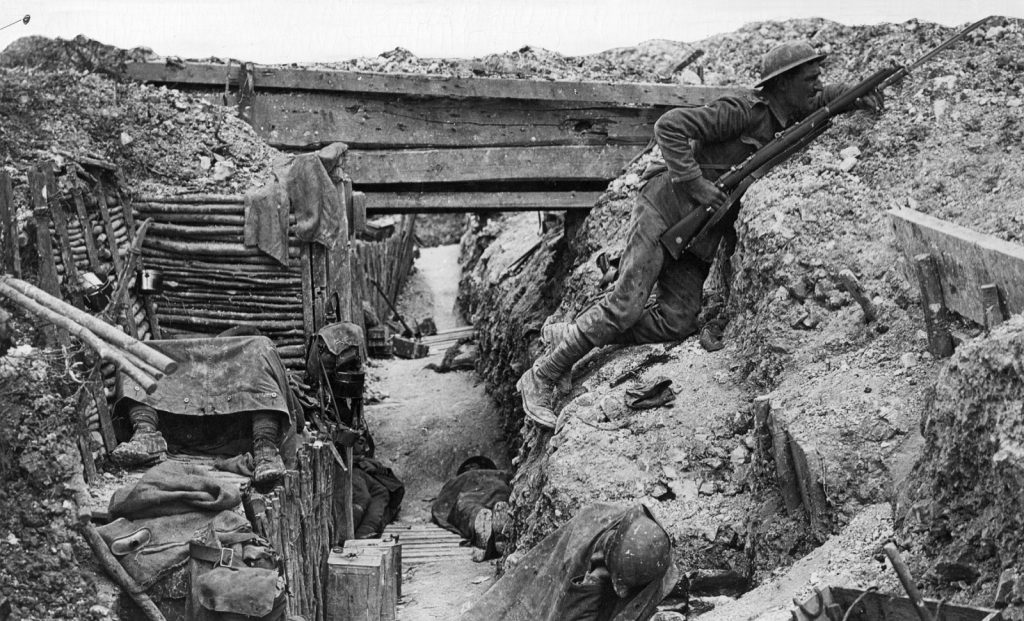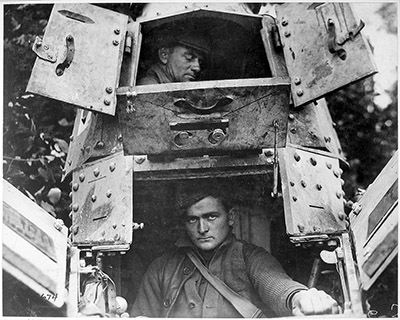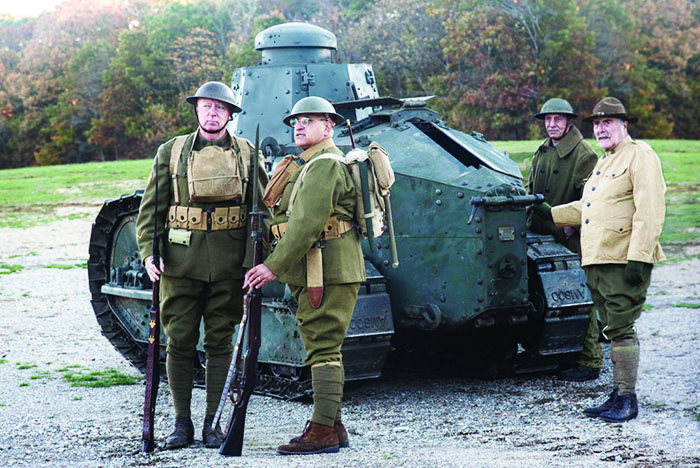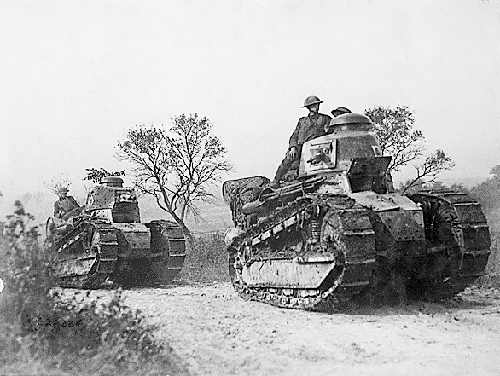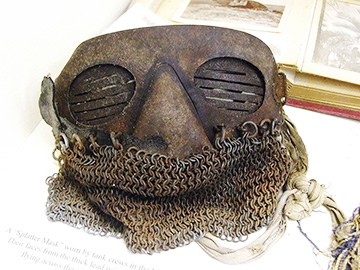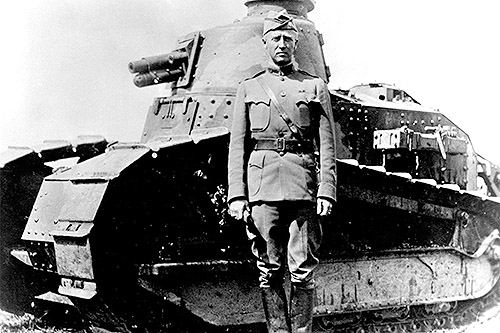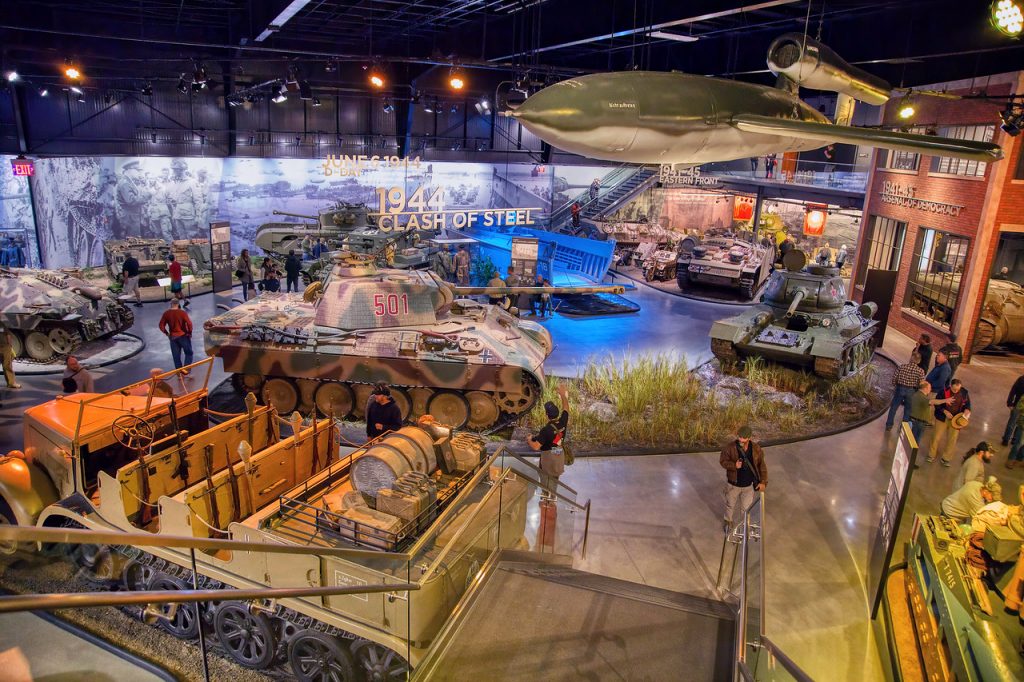The conceptual roots of the tank go back to ancient times, with large mobile siege shelters that were able to provide protection for troops moving up against large stone walls or fortifications. One of the earliest concepts of a tank comes from Leonardo da Vinci. He came up with a sketch design for an “armored wagon” featuring light cannons arranged on a circular platform covered by a large protective shell. In da Vinci’s time, wars were fought with ships, infantry armed with swords, early muskets and by mounted cavalry with lances. .
In 1487, when da Vinci’s patron, the Duke of Milan, needed defense against warring armies, da Vinci told him…“I will make covered vehicles, safe and unassailable, which will penetrate the enemy and their artillery.” Although the concept of this mobile armored contraption was never developed to a working model, it gave birth to the earliest designs of tanks.
Hundreds of years later, with the coming of the Industrial Revolution and the demonstrable power of steam, James Cowan presented a proposal for a Steam Powered Land Ram in 1855, towards the end of the Crimean War. Looking like a helmet on ‘footed’ Boydell wheels, it was essentially an armored steam tractor equipped with cannon and rotating scythes sprouting from the sides. Lord Palmerston is said to have dismissed it as ‘barbaric’.
In 1902, a French armored car was developed called the Charron-Girardot-Voigt. Before World War I, motorized vehicles were still relatively uncommon, and their use on the battlefield was initially limited, especially of heavier vehicles. Armored cars soon became more commonplace in conflicts, especially in more open terrain. On August 23, 1914, the French Colonel Jean Baptiste Eugène Estienne, later a major proponent of tanks, declared: “Gentlemen, the victory will belong, in this war, to the one of the two belligerents who will be the first to succeed in mounting a 75 mm gun on a vehicle capable of moving in all types of terrain.”
Armored cars did indeed prove useful in open land such as in deserts, but were not very good in more challenging terrain and at crossing obstacles such as trenches or large barriers. The other issue was that it was very hard to add much protection or armament to a vehicle frame.
Overall, the main mobility limitation was the wheels, which gave a high ground pressure for the vehicle’s weight. This could be solved by adding more wheels, but unless the 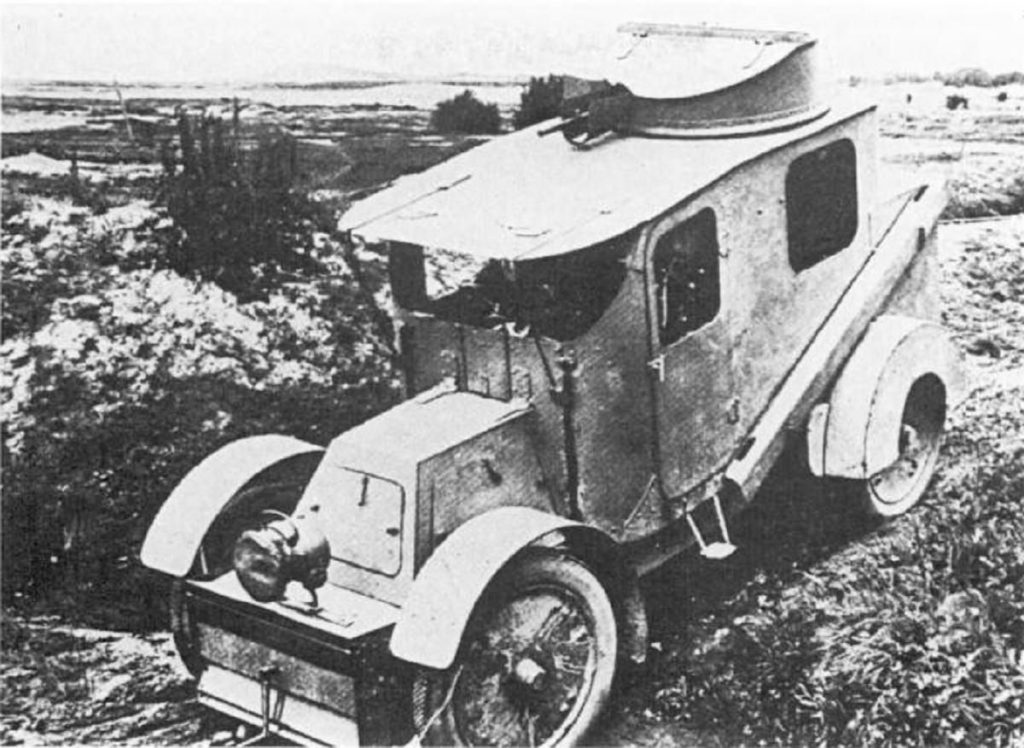 additional wheels were driven, the effect reduced traction on the powered wheels. Driving extra wheels meant more drive train weight, in turn requiring a larger and heavier engine to maintain performance. Even worse, none of this extra weight was put into more protective armor, and the vehicles were still incapable of crossing challenging terrain.
additional wheels were driven, the effect reduced traction on the powered wheels. Driving extra wheels meant more drive train weight, in turn requiring a larger and heavier engine to maintain performance. Even worse, none of this extra weight was put into more protective armor, and the vehicles were still incapable of crossing challenging terrain.
The adoption of caterpillar tracks offered a new solution to the problem. The tracks spread the weight of the vehicles over a much greater area, which was all used for traction to move the vehicle. The limitation on armor and firepower was no longer ground pressure but the power and weight of the power-plant.
From 1904 to 1909, David Roberts, the engineer and managing director of Hornsby & Sons of Grantham, built a series of tractors using his patented ‘chain-track’ which were put through their paces by the British Army (featured above). At one point in 1908, Major William E. Donohue of the Mechanical Transport Committee told Roberts that he should design a new machine with armor, capable of carrying its own gun. But, disheartened by years of ultimately fruitless tinkering for the Army, Roberts did not take up the idea. In later years he expressed regret at not having pursued it.
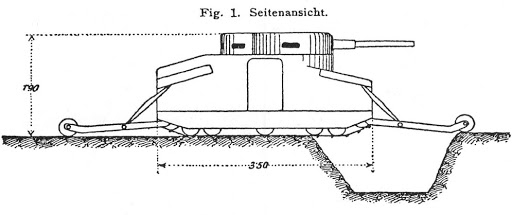
Side view of the Burstyn armored vehicle with rollers extended showing how it could overcome obstacles like a trench.
An engineer in the Austro-Hungarian Army, Lieutenant Gunther Burstyn (inspired by Holt tractors in California) designed a tracked armored vehicle in 1911 carrying a light gun in a rotating turret; equipped also with hinged ‘arms’, two in front and two at the rear, carrying wheels on the ends to assist with obstacles and trenches, it was a very forward-looking design, if rather small. The Austrian government said it would be interested in evaluating it if Burstyn could secure commercial backing to produce a prototype. Lacking the requisite contacts, he let it drop. An approach to the German government was similarly fruitless.
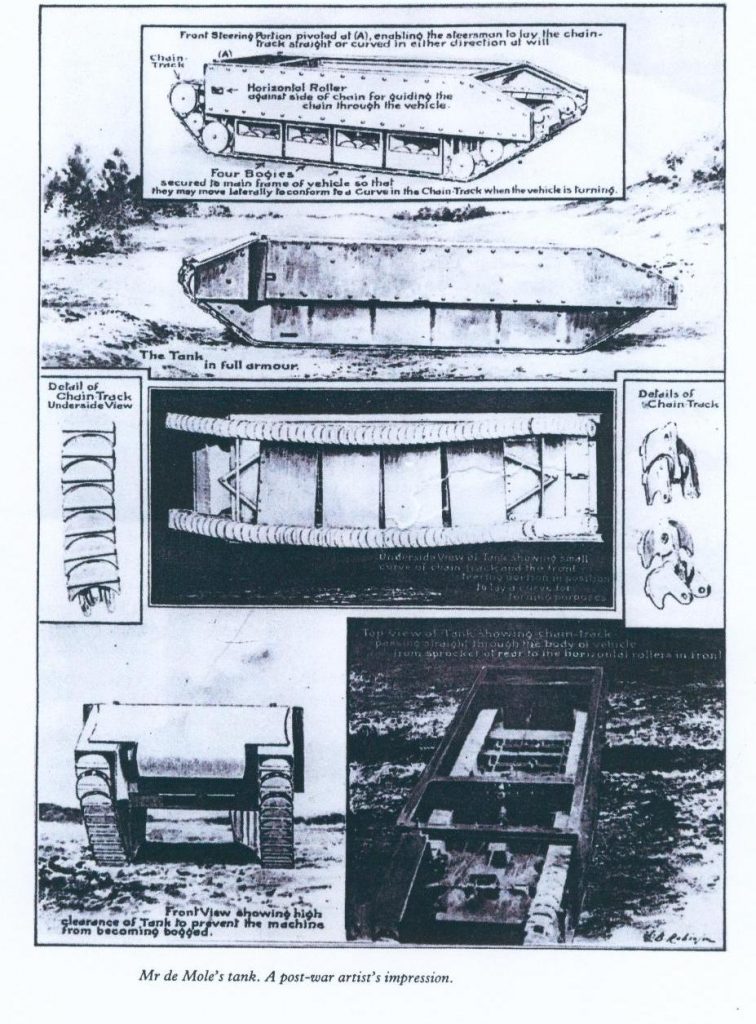 In 1912, a South Australian, Lancelot De Mole, submitted a proposal to the British War Office for a “chain-rail vehicle (featured on the left) which could be easily steered and carry heavy loads over rough ground and trenches.” De Mole made more proposals to the War Office in 1914 and 1916, with a culminating proposal in late 1917, accompanied by a huge one-eighth scale model, yet failed to sway the government. De Mole’s proposal already had the climbing face, that became typical of the later World War I British tanks. At the time it was thought that Mr. De Mole’s ideas had been too advanced for the time to be properly recognized at their face value. The Commission on Awards to Inventors in 1919, which adjudicated all the competing claims to the development of the tank, recognized the brilliance of De Mole’s design, even saying that it was superior to the machines developed at the time. But, the Commission could only make a payment of £987 to De Mole to cover his expenses. De Mole noted in 1919 that he was urged by friends before the war to approach the Germans with his design, but declined to do so for patriotic reasons.
In 1912, a South Australian, Lancelot De Mole, submitted a proposal to the British War Office for a “chain-rail vehicle (featured on the left) which could be easily steered and carry heavy loads over rough ground and trenches.” De Mole made more proposals to the War Office in 1914 and 1916, with a culminating proposal in late 1917, accompanied by a huge one-eighth scale model, yet failed to sway the government. De Mole’s proposal already had the climbing face, that became typical of the later World War I British tanks. At the time it was thought that Mr. De Mole’s ideas had been too advanced for the time to be properly recognized at their face value. The Commission on Awards to Inventors in 1919, which adjudicated all the competing claims to the development of the tank, recognized the brilliance of De Mole’s design, even saying that it was superior to the machines developed at the time. But, the Commission could only make a payment of £987 to De Mole to cover his expenses. De Mole noted in 1919 that he was urged by friends before the war to approach the Germans with his design, but declined to do so for patriotic reasons.
The heightened production of tanks in World War I was a response to the stalemate that developed on the Western Front. Although vehicles that incorporated the basic principles of the tank (armor, firepower, and all-terrain mobility) had been projected in the decade or so before the War, it was the alarmingly heavy deaths at the start of trench warfare that stimulated development. Research took place in both Great Britain and France, with Germany only belatedly following the Allies’ lead.
In Great Britain, one of the first tanks, nicknamed Little Willie (featured below), was constructed at William Foster & Co., during August and September 1915. The prototype of a new design that became the Mark I tank was demonstrated to the British Army on February 2, 1916. 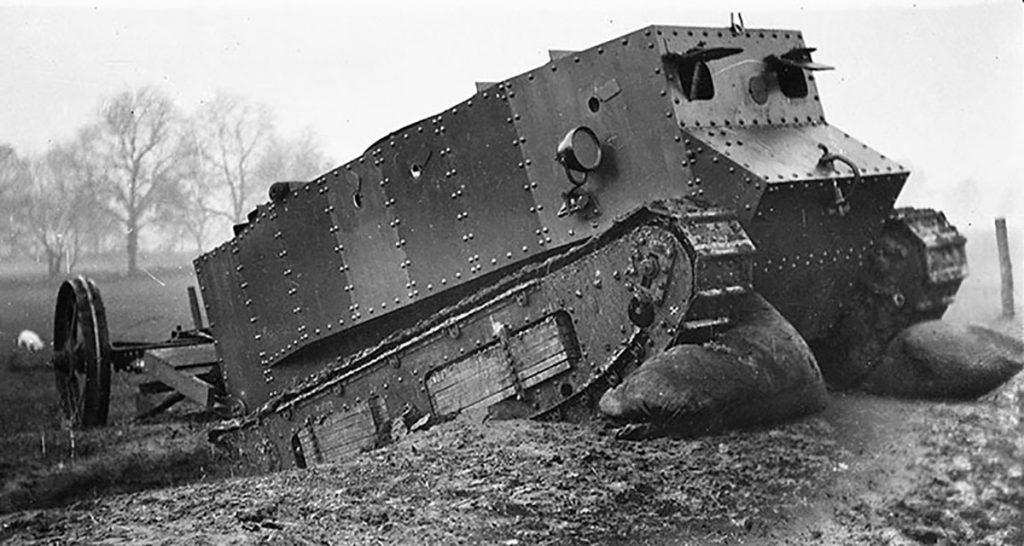 Although initially termed “Landships” by the Landship Committee, production vehicles were named “tanks”, to preserve secrecy. The term was chosen when it became known that the factory workers at William Foster referred to the first prototype as “the tank” because of its resemblance to a steel water tank. The British went on to develop other models of WWI tanks such as the Whippet. This tank was specifically designed to exploit breaches in the enemy front with its relatively higher speed.
Although initially termed “Landships” by the Landship Committee, production vehicles were named “tanks”, to preserve secrecy. The term was chosen when it became known that the factory workers at William Foster referred to the first prototype as “the tank” because of its resemblance to a steel water tank. The British went on to develop other models of WWI tanks such as the Whippet. This tank was specifically designed to exploit breaches in the enemy front with its relatively higher speed.
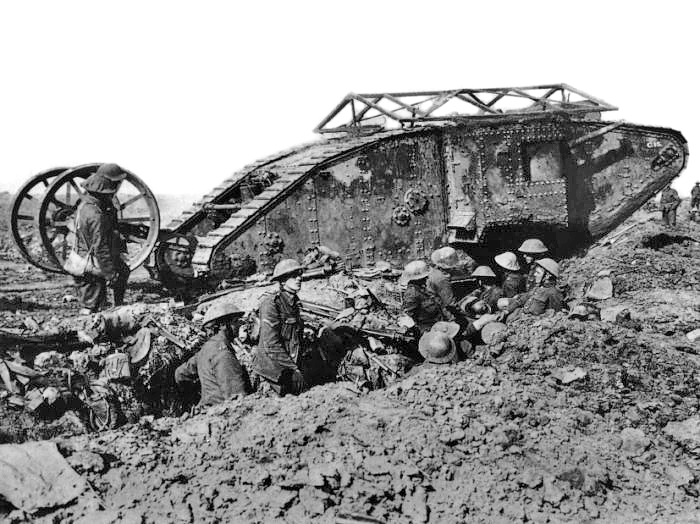
One of the first use of tanks on the battlefield were the British Mark I tanks (featured above) at the Battle of Flers-Courcelette (part of the Battle of the Somme) on 15 September 1916, with mixed results. Many broke down, but nearly a third succeeded in breaking through the trench barriers. Of the forty-nine tanks shipped to the Somme, only thirty-two were able to begin the first attack and able to cross “no man’s land” to the German lines.
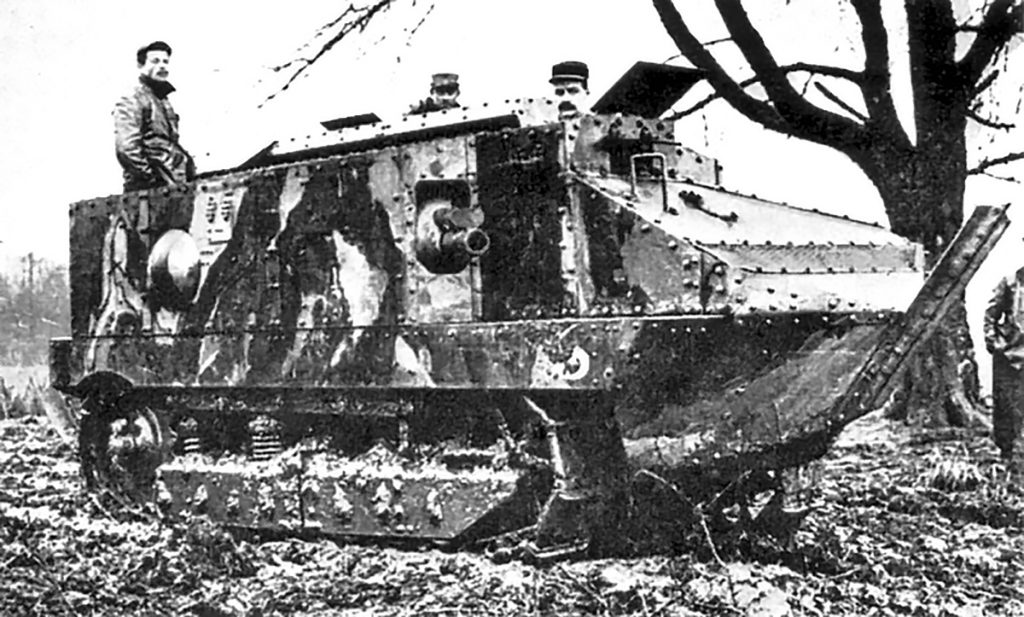 The French fielded their first tanks in April 1917 and ultimately produced far more tanks than all other countries, combined. One of their first introduced was the Schneider CA1 (featured on the right). They went on to develop the long bodied Saint-Chamond tank and then the more agile tanks such as the Renault FT.
The French fielded their first tanks in April 1917 and ultimately produced far more tanks than all other countries, combined. One of their first introduced was the Schneider CA1 (featured on the right). They went on to develop the long bodied Saint-Chamond tank and then the more agile tanks such as the Renault FT.
The Germans began development of their own tanks in response to the appearance of Allied tanks on the battlefield. While the Allies manufactured several thousand tanks 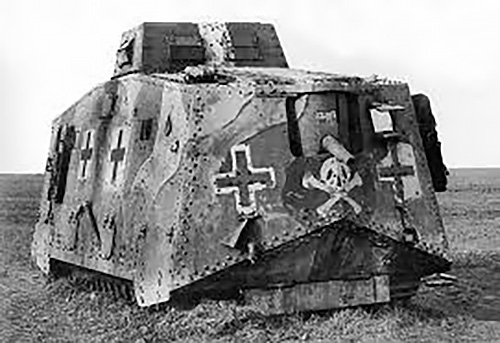 during the war, Germany deployed only 20 of its own. The primary model developed and utilized by the Germans in WWI was the A7V (featured on the left). One hundred chassis were ordered in early 1917, ten to be finished as fighting vehicles with armored bodies, and the remainder as Überlandwagen cargo carriers. The number of A7Vs to be armored was later increased to 20. They were used in action from March to October 1918, and were the only tanks produced by Germany in World War I to be used in combat.
during the war, Germany deployed only 20 of its own. The primary model developed and utilized by the Germans in WWI was the A7V (featured on the left). One hundred chassis were ordered in early 1917, ten to be finished as fighting vehicles with armored bodies, and the remainder as Überlandwagen cargo carriers. The number of A7Vs to be armored was later increased to 20. They were used in action from March to October 1918, and were the only tanks produced by Germany in World War I to be used in combat.
The French Renault FT is considered by most the first ‘modern tank.’ It was Renault’s excellent small tank design in the FT that incorporated a proper climbing face for the tracks, that was the first tank to utilize a top-mounted turret with a full 360° traverse capability. In fact, the FT was in many respects the first truly ‘modern’ tank having a layout that has been followed by almost all designs ever since: driver at the front; main armament in a fully rotating turret on top; engine at the rear. Previous models had been “box tanks,” with a single crowded space combining the role of engine room, fighting compartment, ammunition stock and driver’s cabin.
The FT had the largest production run of any tank of World War One. Over 3700 Renault FTs were built, more numerous than all British tanks combined. Staying with a small tank design was, at first, far from certain. Some in the French army lobbied for the alternative mass production of super-heavy tanks. Much design effort was put in this concept, resulting in the gigantic Char 2C, the most complex and technologically advanced tank of its day. Its very complexity ensured it being produced too late to participate in World War I and in the very small number of just ten. The Char 2C was the first tank with a three-man turret and the heaviest to enter service until late in World War II and still considered one of the largest ever.
To increase the production number of FT tanks, Renault issued the manufacturing license to the United States. The American version of the FT was called the M1917. This was the first American mass-produced tank. Like the FT, the M1917 was designed as an infantry support vehicle, a “moving pillbox” that would lead the way, firing into enemy positions while infantry moved along behind. Only ten of these American built M1917 tanks were delivered to France before WWI ended on November 11, 1918. None of the 11 saw active service on the front line.
The American Heritage Museum has an original M1917 tank in the WWI Trench Experience exhibit. This is one of very few that remain and only one we know of that runs. Looking at the tank, we believe this is one of the ‘test prototypes’ made during production. We came to this conclusion by seeing three precise divots on every major surface made by
ricocheting bullets. Back in the time when there was no definitive in-lab testing of metallurgy, the best way to test the strength of the metal was to put it out in the field and fire a gun at it. If the bullet bounced off the surface, one could surmise that the tank was strong enough to deflect small arms fire.
Regardless of the armor, being a crew member in a tank was still dangerous. Their steel armor could stop small arms fire and fragments from high-explosive artillery shells. However they were vulnerable to a direct hit from artillery and mortar shells. The environment inside was extremely unpleasant; as ventilation was inadequate the atmosphere was heavy with poisonous carbon monoxide from the engine and firing the weapons, fuel and oil vapors from the engine and cordite fumes from the weapons. Temperatures inside could reach temperatures easily passed 100 degrees. Entire crews lost consciousness inside the tanks from carbon monoxide poisoning or heat stroke.
The armor initially made them largely immune to small arms fire, but could be penetrated by the armor-piercing K bullets. There was also the danger of being overrun by infantry and attacked with grenades. The armor thickness was increased making them nearly immune to the K bullets. In response, the Germans developed a larger purpose-made anti-tank rifle, the 3.7 cm TAK 1918 anti-tank gun, and also a Geballte Ladung (“Bunched Charge”)—several regular stick grenades bundled together for a much bigger explosion. To counter the danger of bullet splash or fragments knocked off the inside of the hull, the crew wore helmets with goggles and chain-mail masks (featured above). Fragments were not as dangerous as fire, because of explosive fumes and the large amount of fuel aboard. Gas masks were also standard issue, as they were to all soldiers at this point in the war due to the use of chemical warfare.
During World War One, George S. Patton (who went on to commanded the U.S. Seventh Army in the Mediterranean theater of World War II, and the U.S. Third Army in France and Germany after the Allied invasion of Normandy in June 1944) was one of the first American officers deployed who knew how to operate a tank. The men of the U.S. Army’s 304th tank battalion were so inexperience when the got to France that Patton himself spent time teaching his green crews how to drive them.
Since WWI, thousands of tank models have been produced. The outcomes of major battles have been won and lost by the effectiveness of these mobile armored weapons. The historical chronology of the tank is well defined within the American Heritage Museum. Starting with a scale model of da Vinchi’s concept to the only modern M1A1 Abrams, the variety of tanks that represent major technological advancements is astounding.
We hope you have enjoyed reading this! Stay tuned for more posts from the American Heritage Museum in the weeks to come. Wishing you are yours good health and happiness.

